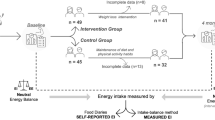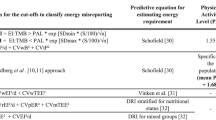Abstract
Objective:
To validate reported energy intake (rEI) with a self-administered diet history questionnaire (DHQ) against total energy expenditure (TEE) by the doubly labeled water (DLW) method.
Subjects:
A total of 140 healthy Japanese adults (67 men and 73 women) aged 20–59 years living in four areas in Japan.
Methods:
Energy intake was assessed twice with DHQ over a 1-month period before and after TEE measurement (rEIDHQ1 and rEIDHQ2, respectively). TEE was measured by DLW during 2 weeks (TEEDLW).
Results:
Mean rEIDHQ1 was lower than those of TEEDLW by 1.9±2.4 MJ/day (16.4%, P<0.001) for men and 0.6±1.9 MJ/day (6.0%, P<0.01) for women. In men and women together, 62 subjects (44%) were defined as underreporters (rEIDHQ1/TEEDLW <0.84), 58 (41%) as acceptable reporters (0.84–1.16) and 20 (14%) as over-reporters (>1.16). Pearson correlation coefficient was 0.34 for men and 0.22 for women. After adjustment for the dietary and non-dietary factors related to rEIDHQ1/TEEDLW, the correlation coefficient improved to 0.42 and 0.37, respectively.
Conclusion:
The energy intake assessed with DHQ correlated low to modestly with TEE measured by DLW. In addition, DHQ underestimated energy intake at a group level. Caution is needed when energy intake was evaluated by DHQ at both individual and group levels.
This is a preview of subscription content, access via your institution
Access options
Subscribe to this journal
Receive 12 print issues and online access
$259.00 per year
only $21.58 per issue
Buy this article
- Purchase on Springer Link
- Instant access to full article PDF
Prices may be subject to local taxes which are calculated during checkout

Similar content being viewed by others
References
Andersen LF, Tomten H, Haggarty P, Lovo A, Hustvedt BE (2003). Validation of energy intake estimated from a food frequency questionnaire: a doubly labelled water study. Eur J Clin Nutr 57, 279–284.
Barrett-Connor E (1991). Nutrition epidemiology: how do we know what they ate? Am J Clin Nutr 54 (Suppl 1), 182S–187S.
Bathalon GP, Tucker KL, Hays NP, Vinken AG, Greenberg AS, McCrory MA et al (2000). Psychological measures of eating behavior and the accuracy of 3 common dietary assessment methods in healthy postmenopausal women. Am J Clin Nutr 71, 739–745.
Black AE (2000). The sensitivity and specificity of the Goldberg cut-off for EI:BMR for identifying diet reports of poor validity. Eur J Clin Nutr 54, 395–404.
Black AE, Cole TJ (2001). Biased over- or under-reporting is characteristic of individuals whether over time or by different assessment methods. J Am Diet Assoc 101, 70–80.
Black AE, Prentice AM, Coward WA (1986). Use of food quotients to predict respiratory quotients for the doubly labelled water method of measuring energy expenditure. Hum Nutr Clin Nutr 40C, 381–391.
Hill RJ, Davies PS (2001). The validity of self-reported energy intake as determined using the doubly labelled water technique. Br J Nutr 85, 415–430.
Ishikawa-Takata K, Tabata I, Sasaki S, Rafamantanantsoa HH, Okazaki H, Okubo H et al. (2007). Physical activity level in healthy free-living Japanese estimated by doubly labelled water method and International Physical Activity Questionnaire. Eur J Clin Nutr advance online publication, 23 May 2007; doi:10.1038/sj.ejcn.1602805.
Johansson L, Solvoll K, Bjørneboe G-EA (1998). Under- and overreporting of energy intake related to weight status and lifestyle in a nationwide sample. Am J Clin Nutr 68, 266–274.
Kroke A, Klipstein-Grobusch K, Voss S, Moseneder J, Thielecke F, Noack R et al. (1999). Validation of a self-administered food-frequency questionnaire administered in the European Prospective Investigation into Cancer and Nutrition (EPIC) Study: comparison of energy, protein, and macronutrient intakes estimated with the doubly labeled water, urinary nitrogen, and repeated 24-h dietary recall methods. Am J Clin Nutr 70, 439–447.
Livingstone MB, Black AE (2003). Markers of the validity of reported energy intake. J Nutr 133 (Suppl 3), S895–S920.
Livingstone MB, Prentice AM, Strain JJ, Coward WA, Black AE, Barker ME et al. (1990). Accuracy of weighed dietary records in studies of diet and health. BMJ 300, 708–712.
Matsuzawa Y, Inoue S, Ikeda Y, Sakata T, Saito Y, Sato Y et al. (2000). The judgment criteria for new overweight, and the diagnostic standard for obesity. Obes Res 6, 18–28. (in Japanese).
Ministry of Health Welfare (1999). Recommended dietary allowance for Japanese: dietary reference intakes. 6th revised edn Ministry of Health and Welfare: Tokyo. (in Japanese).
Okubo H, Sasaki S, Hirota H, Notsu A, Todoriki H, Miura A et al. (2006). The influence of age and body mass index to relative accuracy of energy intake among Japanese adults. Public Health Nutr 9, 651–657.
Saltzman E, Roberts SB (1995). The role of energy expenditure in energy regulation findings from a decade of research. Nutr Rev 53, 209–220. Review.
Sasaki S, Ushio F, Amano K, Morihara M, Todoriki O, Uehara Y et al. (2000). Serum biomarker-based validation of a self-administered diet history questionnaire for Japanese subjects. J Nutr Sci Vitaminol (Tokyo) 46, 285–296.
Sasaki S, Yanagibori R, Amano K (1998). Self-administered diet history questionnaire developed for health education: a relative validation of the test-version by comparison with 3-day diet record in women. J Epidemiol 8, 203–215.
Sawaya AL, Tucker K, Tsay R, Willett W, Saltzman E, Dallal GE et al. (1996). Evaluation of four methods for determining energy intake in young and older women: comparison with doubly labeled water measurements of total energy expenditure. Am J Clin Nutr 63, 491–499.
Science and Technology Agency (2000). Standard Tables of Food Composition in Japan 5th revised edn Printing Bureau, Ministry of Finance: Tokyo. (in Japanese).
Subar AF, Kipnis V, Troiano RP, Midthune D, Schoeller DA, Bingham S et al. (2003). Using intake biomarkers to evaluate the extent of dietary misreporting in a large sample of adults: the OPEN study. Am J Epidemiol 158, 1–13.
Tooze JA, Subar AF, Thompson FE, Troiano R, Schatzkin A, Kipnis V (2004). Psychosocial predictors of energy underreporting in a large doubly labeled water study. Am J Clin Nutr 79, 795–804.
Trabulsi J, Schoeller DA (2001). Evaluation of dietary assessment instruments against doubly labeled water, a biomarker of habitual energy intake. Am J Physiol Endocrinol Metab 281, E891–899.
Weir JBdV (1949). New methods for calculating metabolic rate with special reference to protein metabolism. J Physiol 109, 1–9.
Willett WC, Lenart E (1998). Reproducibility and validity of food-frequency questionnaires. In: Willett WC (ed). Nutritional epidemiology, 2nd edn. Oxford University Press: New York. pp 101–147.
Zhang J, Temme EH, Sasaki S, Kesteloot H (2000). Under- and overreporting of energy intake using urinary cations as biomarkers: relation to body mass index. Am J Epidemiol 152, 453–462.
Author information
Authors and Affiliations
Corresponding author
Additional information
Guarantor: S Sasaki.
Contributors: HO conducted the field management, data collection, statistical analysis and wrote the paper. SS conducted the study design and edited the paper. HHR, KIT and HO conducted data collection and IRMS analyses. IT conducted the overall management. All authors participated in the discussion and interpretation of the results, and in drafting and editing the paper.
Rights and permissions
About this article
Cite this article
Okubo, H., Sasaki, S., Rafamantanantsoa, H. et al. Validation of self-reported energy intake by a self-administered diet history questionnaire using the doubly labeled water method in 140 Japanese adults. Eur J Clin Nutr 62, 1343–1350 (2008). https://doi.org/10.1038/sj.ejcn.1602858
Received:
Revised:
Accepted:
Published:
Issue Date:
DOI: https://doi.org/10.1038/sj.ejcn.1602858
Keywords
This article is cited by
-
Association between serum leptin concentrations and homeostasis model assessment-insulin resistance of 2.5 and higher in normal weight Japanese women
Scientific Reports (2023)
-
Higher childhood weight gain, lower skeletal muscle mass, and higher cereal consumption in normal-weight Japanese women with high-percentage trunk fat: a subanalysis study
Diabetology International (2023)
-
Relationship between body mass index and masticatory factors evaluated with a wearable device
Scientific Reports (2022)
-
Association between vegetable consumption and calf venous compliance in healthy young adults
Journal of Physiological Anthropology (2020)
-
Association between dietary intake and the prevalence of tumourigenic bacteria in the gut microbiota of middle-aged Japanese adults
Scientific Reports (2020)



